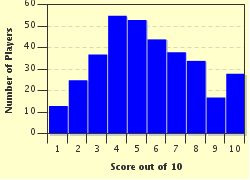Quiz Answer Key and Fun Facts
1. Which of the following is not one of the African "Great Lakes"?
2. Which of these African mountain ranges is NOT situated in the Sahara Desert?
3. Which of the following is not one of the official climate types of Africa?
4. The Intertropical Convergence Zone (ITCZ) is an area of low pressure near the equator in Africa. Throughout the year the ITCZ shifts due to the locations of the sun, and with these ITCZ shifts comes rain. Which of these climate types of Africa is the least affected by the seasonal ITCZ shifts?
5. Which of the following African coastal currents affects the Southwestern Atlantic coast of Africa?
6. Which of the following is a large basin in Southern Africa?
7. Which of the following is not one of the man-made lakes of Africa?
8. Which of the following types of soil in Africa is the most fertile?
9. The orographic, or relief, effect of the ocean currents in Africa creates dry spots on particular sides, or slopes, of mountains. What is the name of the slopes that have these dry spots?
10. What is the second largest country in Africa?
Source: Author
schuhmacher
This quiz was reviewed by FunTrivia editor
Pagiedamon before going online.
Any errors found in FunTrivia content are routinely corrected through our feedback system.


